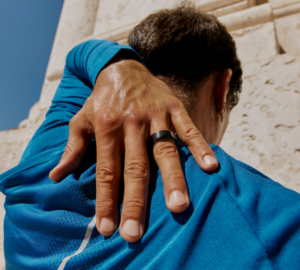Take a walk. It sounds almost too simplistic a tip to benefit your heart health. But extensive research has proven the adage to be true.
Still, you might be wondering: How many steps do I actually need? And how much do I need to walk to lower my cardiovascular disease risk? Read on to find out how many steps per day can actually yield health outcomes.
| Member Tip: Track your daily step count with Oura, and see whether increasing your steps may impact your Cardiovascular Age. |
How Many Steps Do You Need Per Day?
If you were to ask someone (or Google) how many steps per day you need to be “healthy,” you’d likely get “10,000 steps” back as your answer. However, where did this number come from, and why do we all follow it as gospel?
The 10,000-step goal can be traced back to a marketing campaign by a Japanese pedometer manufacturer in the 1960s. The name “manpo-kei” in Japanese translates to “10,000 steps meter.” The campaign was a success, and the 10,000-step goal was then widely adopted, but it’s not the only way to experience health benefits from a walking routine.
In fact, the aforementioned study found that even walking 2,500 to 4,000 steps per day had clear benefits that outweigh being sedentary.
Other research has indicated that around 7,000 steps per day is the ideal step goal: A 2021 study published in Nutrition, Obesity, and Exercise found that 7,000 steps a day was associated with a 50-to-70% lower risk of premature mortality.
Another study from 2019 had similar findings, attributing 7,500 steps per day to optimal health outcomes. Interestingly, the study found that the benefits of walking leveled off after 7,500 steps.
Ultimately, any steps are better than none. If you can comfortably achieve 10,000 steps per day, great. If the thought of 10,000 feels 1) unattainable or 2) all-or-nothing as it relates to your health, don’t worry, you have other options (like just lowering your step count to something you can be consistent with).
| Member Tip: Your personalized, daily activity goal on the Oura App automatically adjusts depending on your Readiness Score. When you’ve got a high Readiness Score, your activity score will reflect this, indicating that your body is ready for movement. |
Additional research confirms that the more you walk, the more health benefits you’ll reap.
In a 2023 study, researchers conducted a meta-analysis using data from 17 individual studies and more than 226,000 participants. They discovered that every 1,000-step increment was linked to a 15% reduction in all-cause mortality, while every 500-step increment reduced cardiovascular mortality by 7%. The more participants walked, the greater the cardiovascular benefits—upwards of 11,000 steps per day.
An earlier study supported these findings, concluding that walking 10,000 steps per day reduced blood pressure, improved maximum oxygen intake (VO2 max), lowered resting heart rate, and reduced sympathetic nerve activity—all important indicators of cardiovascular health.
READ MORE: How Oura Measures Steps
How Long Does it Take to Walk 10,000 Steps?
10,000 steps is equivalent to about 5 miles, or 8 km. Depending on how fast you walk, this can take you an hour and a half—or more.
While any amount of walking is beneficial to your health, upping the pace can be even better for your heart health. A study from May 2024 found that brisk walking was protective against cardiovascular disease. In fact, the researchers found that a 1 mph increase in walking pace corresponds to a 63% reduction in coronary artery disease risk!
Remember: You don’t have to get all your steps in at once. When you track your steps using Oura, you may be surprised to learn that your daily routine is already doing the step work. Or, by making small adjustments to your routine, you can easily hit your step target—keep reading for some tips.
| Member Story: Oura member and new mom Bridgette S. was pleasantly surprised to discover she was walking around 10,000 steps per day looking after her toddler, despite not working out as much as she used to. |
A Step a Day Keeps the Doctor Away: The Health Benefits of a Consistent Walking Routine
- Better sleep: More daily steps is linked to greater sleep quality.
- Lower stress: Even a 10-minute bout of brisk walking has been shown to lower stress and improve overall mood.
- Improved mental health: A 2016 study found that walking 10,000 steps per day was linked to significant improvements in mental health—lower anxiety, depression, anger, fatigue, confusion, and distress.
- Greater cardiovascular and metabolic health: Walking, particularly brisk walking, was associated with lower blood glucose, blood pressure, and higher vitamin D3 levels.
- May support weight loss: Participants who walked 10,000 steps per day for 36-weeks reduced total body weight, body mass index, body fat percentage, fat mass, waist circumference, hip circumference, and cholesterol.
- May improve VO2 Max: A study found that walking 10,000 steps per day reduced blood pressure, improved maximum oxygen intake (VO2 max), lowered resting heart rate, and reduced sympathetic nerve activity —all important indicators of cardiovascular health.
RELATED: Learn How to Improve Your Cardio Capacity (VO2 Max)
Simple Strategies to Boost Your Step Count
The great news: walking is a free, totally attainable way to get daily exercise that involves no equipment. Here are some easy ways to seamlessly integrate more steps into your day that are manageable, enjoyable, and beneficial to your health.
Start small. Aim to increase your daily steps by 500 steps each week to gradually build up your stamina.
Take the stairs. Choose stairs over elevators or escalators to add extra steps throughout your day.
Set inactivity alerts with Oura. In your Oura App settings, you can enable inactivity alerts to receive a friendly reminder to get some movement in after 50 consecutive minutes of inactivity.
Walk and talk. Add some movement to your phone calls or virtual meetings when possible to incorporate more movement into your routine.
Listen to audiobooks or podcasts. Turn on your favorite podcast or audiobook, enriching your mind while moving your body.
Explore new routes. Keep your walks interesting by discovering new areas and changing your walking paths.
Park further away. Increase your steps by parking farther from entrances when shopping or going to work.
READ MORE: Oura’s Automatic Activity Detection Now Includes Average Heart Rate and Heart Rate Zones






